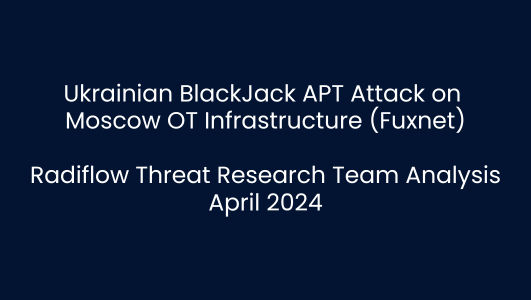In May 2021, a ransomware attack against Colonial Pipeline forced the company to shut down about 5,500 miles its pipeline system, which runs from Texas to New Jersey and provides approximately 45% of the U.S. East Coast’s fuel supply. The days-long shutdown and gradual reopening led to higher gas prices, fuel hoarding and shortages in some U.S. states.
The Colonial Pipeline attack demonstrated the potential catastrophic effect of even a short-term shutdown of a single component of a country’s ONG drilling, delivery, distillation, storage and distribution infrastructure. The threat is compounded by the increasing sophistication of attackers, often state-sponsored; the overall increase in attacks against industrial operations; and the ongoing process of digitalization & automation of traditional industries.
Unfortunately, many ONG companies around the world still lack the defenses needed to prevent a major shutdown, and have yet to adopt a systemic approach of continuous cyber risk management.
Download Oil & Gas Use Case
Challenge: Securing the Lifeblood of all Economic Activity
Oil and natural gas derivatives still by far make up the bulk of the fuel used for transportation, manufacturing and energy. Therefore, disruptions to any stage in the supply chain may cause of chain reaction of disruptions:
• Blackouts and brownouts in natural gas-powered isolated electric grids
• Utilities partial or full shutdown, from water purification and supply to trash disposal
• Shortages of heating fuel in cold areas
• Gasoline and diesel fuel shortages, leading to higher gas prices at the pump, higher shipping costs for goods and higher travel costs
• Oil spills due to storage facility failures or deliberate sabotage
• Damage to ONG companies’ equipment and facilities, heavy losses to stakeholders in the case of longer shutdowns
Challenge: Securing Oil & Gas Facilities
Like other critical industrial sectors, the ONG industry is on one hand embracing digitization, which means greater exposure to an altogether new landscape of attack vectors for hackers by connecting upstream operations in real time.
Intelligent field instrumentation – the devices that monitor activity levels, collect data and execute operations – have become the preferred target for hackers, as they’re typically less protected than central operations systems. By gaining access to device controllers, hackers could change operational values such as pump speeds or valve state, and bring down entire swaths of the fuel supply chain.
At the same time, the ONG industry is slow to implement changes due to scale, complex ownership and operational structures, and extensive government regulation and oversight, including API 1164 for pipeline control systems, API 780 for risk assessment methodology, ISA/IEC-62443 for network security), INGAA cybersecurity guidelines for the natural gas sectors and many other local standards and regulations worldwide.
In addition, the distributed nature of ONG operations and the location of facilities – off-shore rigs or remote unmanned facilities – introduce both physical and cyber-vulnerabilities to the OT network; and the use of multiple vendors’ networked devices poses the danger of supply chain attacks, executed through infected data payloads sent by vendors to installed devices.
As a whole, the level of network security in many ONG companies highly differs between companies, according to a February 2020 research commissioned by the US Dept of Energy’s Office of Scientific and Technical Information (OSTI). The “general consensus” is that the ONG is lagging behind the power supply industry in securing operations, and that the industry on a whole is unaware of potentially useful technologies that have been developed for ensuring cyber-security of other infrastructure systems.
Challenge: A Structured Approach to Securing ONG Production
There’s no “silver bullet” for effectively protecting any infrastructure’s ICS, and more so cyber-protecting complex ONG operations. Threat mitigation measures need to match each individual network’s topology, technology, device and vendor-specific vulnerabilities, sector, locale and existing security measures.
Not considering each network’s needs and properties would lead to investing in the wrong security controls, lesser security and lower cybersecurity ROI.
The structured process of implementing an effective ICS security system therefore includes:
- Network modeling and visibility: this stage involves creating a model of the oil company’s OT network, including network topology; device properties, state, vulnerabilities and potential inter-zone attack vectors; protocols and ports, etc. This model (or “digital image”) is used for breach and attack simulations, and also provides the user with full network visibility.
- Risk assessment: this stage includes simulating numerous breach attempts into the oil production operational environment, and the ability of installed and proposed security measures to defend the network, accounting for the impact of a shutdown of different industrial units.
- Implementation: The simulation data enables generating an ROI-optimized OT security plan matching the user’s security preferences and budget constraints, and provides the user with key indicators and reports for the network’s risk state. The user is presented with a prioritized list of mitigation measures toward strengthening and optimizing OT security, in accordance with IEC62443.
- Long-term security management: In time, systems grow and evolve, new components are added, and hackers become more sophisticated and determined. The key to long-term system security is ICS network monitoring, which provides constant identification and mitigation of intrusions as well as changes in the risk posture due to new threats.
Radiflow Solutions for ONG Production
Digital Imaging & Network Visualization
Through non-intrusive self-learning, Radiflow’s iSID industrial threat detection and monitoring system constructs an accurate digital image of the ONG production network. The digital image is presented in map form as a visual management tool, down-drillable to all device properties, vulnerabilities and inter-asset attack vectors.
For distributed ONG production networks, the iSAP smart collector provides WAN/LAN-friendly data transfer of real-time data traffic (up to 90% reduction in data volume) from multiple operational units to a central instance of iSID for analysis and monitoring.
Risk Posture & Network Characteristics
Using the learned digital image of the network as well as MITRE ATT&CK and other TI sources, the CIARA industrial risk assessment and management platform conducts numerous non-intrusive/non-destructive Breach & Attack Simulations (BAS) to assess the Risk, Control and Threat levels to different operational units, and the effectiveness of installed and available mitigation controls.
The structured discovery process covers all fundamental requirements (FRs) specified in IEC 62443, and allows simulating other threat types including Supply Chain attacks. The Risk assessment findings are presented to the user in the form of customizable planning and auditing reports.
Ongoing hardening & ROI optimization
Based on its breach simulations and on the user’s budgetary constraints, CIARA produces an ROI-optimized mitigation plan which prioritizes security measures’ effectiveness vis-à-vis the user’s cyber-security preferences (e.g. improve compliance or focus on securing critical production units).
Radiflow’s platform empowers users to take control over setting alerting rules & device communication policies and improve the lifecycle management of networked assets.
For remote ONG production location, Radiflow offers a DPI Secure Gateway/Firewall with work order-based remote access management, to ensure the integrity of maintenance operations and prevent both erroneous and malicious technician activity.
Continuous Threat & Risk Monitoring
All OT networks, and especially those used for critical ONG operations, need to be continuously monitored. Radiflow provides efficient handling of real-time monitoring and handling of operational and security alerts, including early indications of breach attempts, generated by a single or an array of iSID threat detection systems, all through a single pane of glass at the ONG company’s SOC.
In addition Radiflow enables users to continuously assess their network risk posture and adjust their security plans and preferences, to account for the rapidly-changing threat landscape as well as for added or removed devices and other changes to the OT network.
Digital Imaging & Network Visualization
Through non-intrusive self-learning, Radiflow’s iSID industrial threat detection and monitoring system constructs an accurate digital image of the ONG production network. The digital image is presented in map form as a visual management tool, down-drillable to all device properties, vulnerabilities and inter-asset attack vectors.
For distributed ONG production networks, the iSAP smart collector provides WAN/LAN-friendly data transfer of real-time data traffic (up to 90% reduction in data volume) from multiple operational units to a central instance of iSID for analysis and monitoring.
Risk Posture & Network Characteristics
Using the learned digital image of the network as well as MITRE ATT&CK and other TI sources, the CIARA industrial risk assessment and management platform conducts numerous non-intrusive/non-destructive Breach & Attack Simulations (BAS) to assess the Risk, Control and Threat levels to different operational units, and the effectiveness of installed and available mitigation controls. The structured discovery process covers all fundamental requirements (FRs) specified in IEC 62443, and allows simulating other threat types including Supply Chain attacks. The Risk assessment findings are presented to the user in the form of customizable planning and auditing reports.
Ongoing hardening & ROI optimization
Based on its breach simulations and on the user’s budgetary constraints, CIARA produces an ROI-optimized mitigation plan which prioritizes security measures’ effectiveness vis-à-vis the user’s cyber-security preferences (e.g. improve compliance or focus on securing critical production units).
Radiflow’s platform empowers users to take control over setting alerting rules & device communication policies and improve the lifecycle management of networked assets.
For remote ONG production location, Radiflow offers a DPI Secure Gateway/Firewall with work order-based remote access management, to ensure the integrity of maintenance operations and prevent both erroneous and malicious technician activity.
Continuous Threat & Risk Monitoring
All OT networks, and especially those used for critical ONG operations, need to be continuously monitored. Radiflow provides efficient handling of real-time monitoring and handling of operational and security alerts, including early indications of breach attempts, generated by a single or an array of iSID threat detection systems, all through a single pane of glass at the ONG company’s SOC.
In addition Radiflow enables users to continuously assess their network risk posture and adjust their security plans and preferences, to account for the rapidly-changing threat landscape as well as for added or removed devices and other changes to the OT network.
Radiflow’s renowned team of cybersecurity experts takes the guesswork out of OT security by empowering our customers with actionable data.
We can assess your cybersecurity readiness and offer the solutions necessary to protect your operations. If you’re ready for industrial threat detection and risk management decisions backed by research and led by innovation, contact us today.
Learn more about our products




